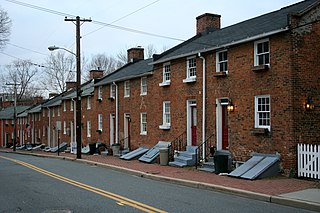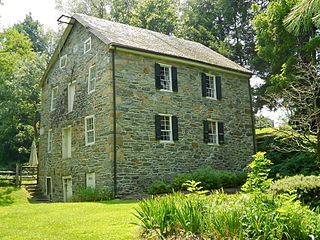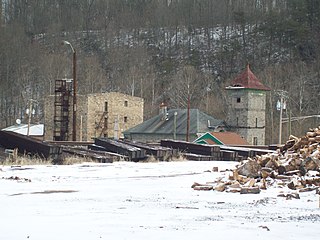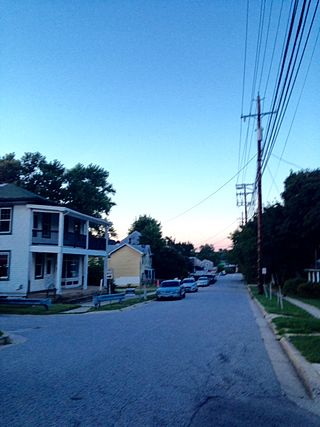
Elkridge is an unincorporated community and census-designated place (CDP) in Howard County, Maryland, United States. The population was 15,593 at the 2010 census. Founded early in the 18th century, Elkridge is adjacent to two other counties, Anne Arundel and Baltimore.

Ellicott City is an unincorporated community and census-designated place in, and the county seat of, Howard County, Maryland, United States. Part of the Baltimore metropolitan area, its population was 75,947 at the 2020 census, making it the most populous unincorporated county seat in the country.

Hampden is a neighborhood located in northern Baltimore, Maryland, United States. Roughly triangular in shape, it is bounded to the east by the neighborhood Wyman Park, to the north by Roland Park at 40th and 41st Street, to the west by the Jones Falls Expressway, and to the south by the neighborhood Remington. The Homewood campus of the Johns Hopkins University is a short distance to the east.

Oella is a mill town on the Patapsco River in western Baltimore County, Maryland, United States, located between Catonsville and Ellicott City. It is a 19th-century village of millworkers' homes.
Robert Cary Long Jr. (1810–1849) was the son of a late 18th Century - early 19th Century famous architect Robert Cary Long Sr. of Baltimore, Maryland and was himself a well-known 19th Century architect. Like his father, Cary was based in Baltimore.

St. Charles College was a minor seminary in Catonsville, Maryland, originally located in Ellicott City, Maryland.

The Mill Green Historic District is a National Register of Historic Places listed community located in Harford County, Maryland. The district consists of a small cluster of privately owned historic homes and buildings including a historic mill. The district is located at the junction of Mill Green Road and Prospect Road. Broad Creek flows through the district. The historic district designation was established in 1993.

The Baltimore and Ohio Ellicott City Station Museum in Ellicott City, Maryland, is the oldest remaining passenger railway station in the United States, and one of the oldest in the world. It was built in 1830 as the terminus of the Baltimore and Ohio Railroad line from Baltimore to the town then called Ellicott's Mills, and a facility to service steam locomotives at the end of the 13-mile (21 km) run. The station, a National Historic Landmark, is now used as a museum.

Ellicott City Historic District is a national historic district in Ellicott City, Howard County, Maryland. The Ellicott City Station is a National Historic Landmark located within the district. The district encompasses a predominantly 19th century mill town whose origins date to 1772, including more than 200 18th- and 19th-century buildings. It was listed on the National Register of Historic Places in 1978. The 2016 Maryland flood severely impacted the historic district on July 30, 2016, as did another flood on May 27, 2018.

Daniels is a ghost town straddling the Patapsco River east of Woodstock and north of Old Ellicott City in Baltimore and Howard counties, Maryland, United States. It is the location of the Daniels Mill, a site listed on the National Register of Historic Places. Daniels is the home town of former Howard County Executive and State Senator James N. Robey. A postal office operated in the community from 1 March 1943 to 31 August 1971.

The Avondale Mill was a large gable-front stone structure, three stories in height, and 10 bays long by three wide. It was located on the bank of the Patuxent River in the city of Laurel, Prince George's County, Maryland. It was constructed in 1844–1845 for Captain William Mason & Son of Baltimore. It was complemented by the neighboring Laurel Mill built in 1811, S.D. Heath's machine shop, and Richard Israel's flouring mill. At that time it was provided with the machinery for the manufacture of fine cloth, running as many as 1,500 cotton spindles with 150 employees. In 1845, industrialist Peter Gorman was responsible for the first macadamized (paved) road in Laurel, Avondale Street next to the new Mill.

Daniels Mill is a historic mill complex located at Daniels, Howard County, Maryland, in a sheltered, wooded valley of the upper Patapsco River. The complex consists of seven early industrial structures, several concrete block and brick structures of 20th century date, and Gary Memorial United Methodist Church, a granite church built in the High Victorian Gothic style with an off-center tower entrance on the west gable. South of the church is a small cemetery.

The Savage Mill Historic District is a national historic district located at Savage, Howard County, Maryland. The district comprises the industrial complex of Savage Mill and the village of workers' housing to the north of the complex.

The Elkridge Furnace Complex is a historic iron works located on about 16 acres (6.5 ha) at Elkridge, Howard County, Maryland.

Knoxville is an unincorporated community in Frederick and Washington counties, Maryland, United States. The Robert Clagett Farm and Magnolia Plantation are listed on the National Register of Historic Places.

Londontown Manufacturing Company, Inc., also known earlier as the Meadow Mill of the old Woodberry Manufacturing Company is a historic cotton mill industrial complex located at Baltimore, Maryland, United States. It is a four-story, Italianate red brick structure that features a square tower structure with a truncated spire-like roof having an open bell tower cupola. It sits on the west bank of the Jones Falls stream which runs north to south, parallel to the elevated Jones Falls Expressway.

Caves Valley Historic District is a national historic district near Owings Mills, Baltimore County, Maryland, United States. It is located in a natural upland valley encompassing about 2,100 acres (8.5 km2) along the North Branch of the Jones Falls and its contributing courses. It includes cultivated fields, pastures, woodlands, streams, housing clusters, and agricultural structures. The vernacular buildings are log, stone, and frame, reflecting the local materials and functional plans of rural locations in the 18th and 19th centuries.

Rockland Historic District is a national historic district at Brooklandville, Baltimore County, Maryland, United States. It is located at the intersection of Old Court Road and Falls Road, where Old Court turns into Ruxton Road. There are 15 buildings in the area, including a general store, tavern, the shell of a blacksmith shop, a carriage house, several log buildings, a group of stone rowhouses, the Rockland Grist Mill, and an 18th-century dwelling. It is one of the surviving examples of a small, quiet, sylvan community of the early 19th century.

The Easton Historic District is a historic district that covers most of the core of the town of Easton, Maryland. The town is the county seat of Talbot County. The state of Maryland is nearly split by the Chesapeake Bay, and Easton is located on the east side of the bay that is known as Maryland's Eastern Shore. Although the town is part of the east coast of the United States, the region's history goes back to a time when Maryland was a colonial province of England.

Elkridge Landing was a Patapsco River seaport in Maryland, and is now part of Elkridge, Maryland. The historic Elkridge Furnace Inn site is in Patapsco Valley State Park.


























